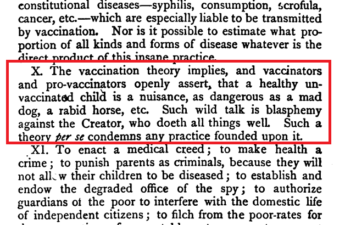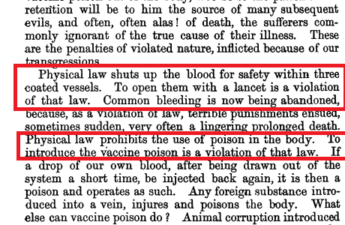
Throughout vaccine history, data manipulation has been employed to make this fraudulent practice appear effective.
When it came to smallpox vaccination, one method of hiding its failure (and even danger, since it was deadly) was by observing “visible marks,” or scars at the vaccination site (the arm), to “show” that many who suffered from, and even died from, smallpox were unvaccinated.
In short, one or more vaccine scars on your arm was “proof” of vaccination (like a vaccine passport) — and if you suffered from smallpox without such proof, then surely — as the narrative goes — you were not vaccinated.
This, of course, enabled the vaccinators to in many cases deny vaccination was to blame when it failed to protect one from smallpox — or even caused one’s death (such as from vaccine-induced smallpox).
Let’s look at the historic critiques. In 1879 Henry Pitman writes:
Another vaccination fallacy is, that its supposed “protection” is in proportion to the number of “marks.” Who counts the marks on the patients? Interested persons; and consequently when the marks are obliterated by the disease, the partisans of the poisoning theory give their fallacy the benefit of the doubt, and generally register the patients as “unvaccinated.”
Henry Pitman, Vaccination Fallacies, The Vaccination Inquirer and Health Review, No. 9, December 1879, in The Vaccination Inquirer and Health Review, Volume the First, April 1879 to March 1880 (London: Edward W. Allen, 1880), 128.
What does it mean to say that the marks are “obliterated by the disease”?
That smallpox eruptions can conceal vaccine marks — especially so when the disease is fatal. And so, Dr. Eugene Bettes writes in The Sortation Theory of Vaccination: Proving Vaccination a Failure (1920)
[T]he site of vaccination is apt to be invaded by the smallpox pustules, and the more recent the vaccination the greater the chance of obscuration partial or total of the scars. Thus an individual who may have had in health six or even more visible vaccine scars will, after the variolous eruption has made its complete appearance, show on examination five, four, three or two scars or no scar, according to the severity of the disease.
The vaccinators as a rule avail themselves of this peculiarity and by refusing to count as vaccinated any who do not present visible vaccine scars they are enabled to throw many of the fatal cases occurring among the vaccinated into the unvaccinated column or alternatively into a class called “doubtful” or “Said to be vaccinated but without visible marks.” In the Gloucester, England epidemic of 1896 there were 40 cases of alleged vaccination but with no vaccine scars visible. The fatality of this group was 57 per cent. Of these Dr. Coupland reports: “The profuseness of the rash, concealing the sites of vaccination, accounts for the rather large proportion of the ‘alleged vaccination class.’” This is practically an admission that they were all vaccinated. Dr. Savill reports as to the Warrington epidemic: “In nearly all fatal cases the eruption is profuse and tends to hide the vaccination scars if they exist.” It should be borne in mind that these parties were unwilling witnesses. They were confronted with the necessity of admitting that the vaccine scars were hidden when the eruption was profuse or else that the statistics in these towns as well as elsewhere were deliberately falsified.
Eugene Bettes, The Sortation Theory of Vaccination: Proving Vaccination a Failure (Baltmore, MD: Peoples Printing Company, 1920), 15, 16.
Dr. Bettes goes on to note, however, that the vaccinators may actually count those without scars as vaccinated — at least so long as such people do not have smallpox. But, when one catches smallpox, scars become again the exclusive criterion for determining vaccination status:
If a person is vaccinated by a competent party using virus that proves effective in other cases, and after three trials there is no inflammatory result such person is in theory immune to smallpox. There is no fact basis for this theory but it is very convenient because persons showing this peculiarity can be classed as vaccinated as long as they remain free from smallpox and as unvaccinated when they contract the disease.
A few years ago Dr. Stanton of Philadelphia, died of smallpox. He had been vaccinated twenty-four times without success, yet if he was sent to the Municipal Hospital, as he presumably was, he was classed as unvaccinated because he had no visible marks on his arm. In Washington in 1895, Mrs. Maggie Pemberton was vaccinated three times without success, adjudged an immune and employed as a nurse in the smallpox hospital where she promptly became a patient and added to the death roll of the unvaccinated.
We are told by a Boston physician that: “The fact that physicians and nurses who have been constantly exposed to the contagion and in two instances under my own observation have been inoculated with the virus upon abrasions of the hand while they showed no trace of a vaccine cicatrix yet have not suffered from the disease, is certainly strong evidence that vaccination may protect without any external mark whatever.”
We are not told, however, the fact that if any one of these doctors or nurses had contracted smallpox he would have been treated in the same hospital and classed as unvaccinated.
In the Marine Hospital at Baltimore during the 1871-73 epidemic, Dr. Summerfield observed “many instances in which the disease attacked persons who had been repeatedly vaccinated without success.” This means that in “many instances” patients were improperly classed as unvaccinated.
Ibid., 16, 17.
But the “marks” deception goes even further.
There are those who died without marks who were truly unvaccinated and yet not such because they opposed vaccination — but because their doctors refused to vaccinate them due to their poor health. If vaccination could be a death sentence in the typical patient, it was more likely to be so for them.
And yet, despite the impossibility in such cases of being vaccinated, according to William Gibson Ward, they would be shamelessly held up as cautionary tales for the general public against being unvaccinated:
These were confluent cases—then, no vaccination marks can be seen, at once the doctor writes down unvaccinated ; giving the idea to the people that there is strict connection as of cause and effect—no vaccination, therefore virulent small-pox and death. Thus the doctor gets up a panic, frightens the people out of their reason, then sets up a shop, to sell vaccination and re-vaccination. … Generally, upon examination, these unvaccinated cases turn out to be medical frauds. But there are unvaccinated waifs of humanity, the ready fuel for any epidemic. But these are not unvaccinated because they had fathers with conscientious scruples, and good sense to refuse to allow them to be polluted. They are unvaccinated because the vaccinating doctor refused to vaccinate them. The medical polluters know that it requires a strong child to fight down the poison of vaccination. The poor wailing, half-fed things, with the skin chafed at the joints, or any skin eruption, they send back with the message, bring them again in six months. They are seldom taken again. They vegetate; drag on a miserable existence ; and then small-pox comes and sweeps them off like flies in a frost. Then the doctors, ever adepts at deception and fraud, say, not the whole truth, but intimate that these victims are the work of our teaching — when they know that to vaccinate them would have been to murder them.
William Gibson Ward, “Outbreak of Small-pox!”, National Anti-compulsory-vaccination Reporter, Vol. V, No. 4, January 1, 1881, ed. Mrs. Hume-Rothery, in National Anti-compulsory-vaccination Reporter, Vol. V, October 1880 – September, 1881, ed. Mrs. Hume-Rothery, 202, 203.
Vaccination is a never-ending game of shifting goalposts to accommodate a fraudulent and murderous practice. Moving targets are harder to hit — let alone to identify. The vaccinators — at least those at the top who really understand the game — have learned the deceptive tricks to their craft very well over the past few centuries.

If you find this site helpful, please consider supporting our work.


